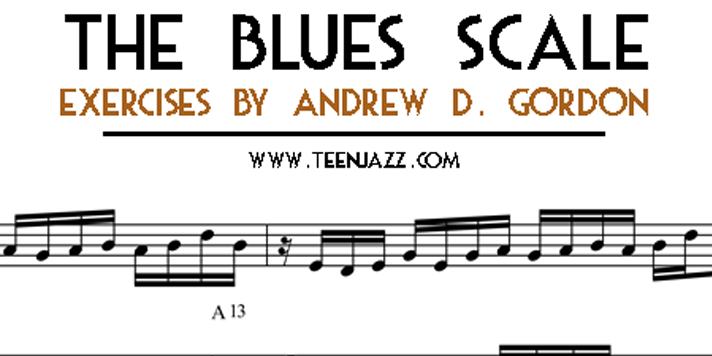The Blues scale is, I feel, one of my most important scales to learn as it can be used to improvise in many styles of contemporary music such as: Pop, Rock, Blues, Jazz, Funk, R&B, Latin, Gospel, New Age, Reggae, Calypso.
The Blues Scale
Learning the blues scale is a great way to start your exploration into improvisation and can be applied to pretty much any style of music.
Download the PDF Exercise Sheet and Playalong Tracks (Free)
The example above shows the C blues scale (seven note scale) and consists of the following notes based on the major scale of C : root note C, the flat third Eb, fourth F, sharp fourth or flat fifth F# or Gb, fifth G, flat seventh Bb, octave C. The interval between the first and second notes of the scale C to Eb is 11/2 steps, the interval between the second and third notes is 1 step, the interval between the third and fourth notes is ½ step, the interval between the fourth and fifth notes is ½ step, the interval between the fifth and sixth notes is 11/2 steps and the interval between the sixth and seventh notes is one step.
It is of primary importance to memorize the scale practicing going up and down the scale as well as learning the intervals between the notes. The same intervals apply to the blues scale in the other eleven keys so practice these blues scales as well. This scale can be used over both major and minor keys. The blues scale gives color or dissonance when played over a major chord, the Eb of the C blues scale against the E natural of the C major chord giving that bluesy sound.
This blues scale provides the beginner improviser with an easy way of playing the same scale over the chord progressions and sounding “bluesy”, however, improvising using the notes of this blues scale can become somewhat tiresome when overused and the blues scale of the relative minor of the key can also be used when playing in a major key adding the 2nd, 3rd and 6th notes of the major scale, creating variation in the improvisation. In the example below the 2nd, 3rd and 6th notes of the major scale “C” are the notes of D, E and A respectively.
The A blues scale, (relative minor of C) as described in the previous paragraph, uses the same series of notes in the scale and intervals as the C blues scale.
Going further, we can combine both the major and relative minor blues scales together producing a scale that has a chromatic run from the second to the fifth giving a more jazzier sound to your improvisation.
Learning, memorizing and playing these scales and patterns so that they make sense musically can take some time so please be patient with yourself as you develop these skills, it is similar to learning a new language whereby you first learn words, then phrases, sentences etc.
Notes and Tips:
When playing a 12 Bar Blues progression whether in a major or minor key, you can play the blues scale of that key through the whole progression even though the chords are changing. As mentioned previously, when playing in a minor key the blues scale of that minor key is generally the only blues scale used.
Download the PDF Exercise Sheet and Playalong Tracks (Free)
Want more great advice and music lessons like this?Andrew D Gordon has over 100 books available through his publishing company ADG Productions for a variety of instruments and in a large collection of styles. |
 Written by – Andrew D Gordon, Teen Jazz Contributor
Written by – Andrew D Gordon, Teen Jazz Contributor
Andrew D Gordon is a pianist, educator and founding member of the Smooth Jazz group The Super Groovers. He was born in London, England and moved to Los Angeles in 1979 where he has since had the opportunity to perform with several notable musicians. He owns ADG Music Production, a music education company with over 100 publications in a variety of music genres for most instruments. He is currently a professor at Shepherd University and CSCM.
[template id=”182″]



